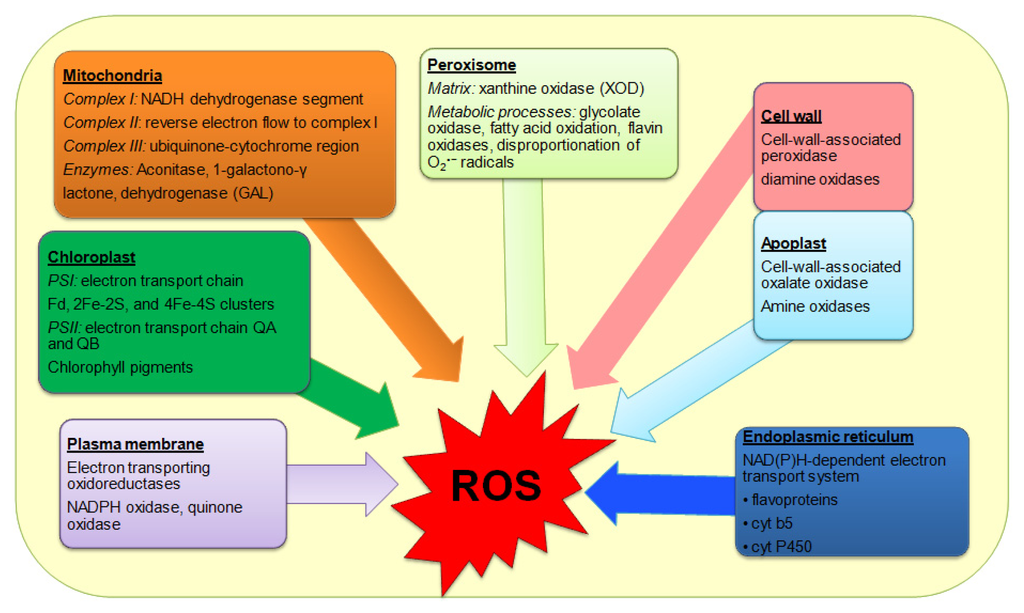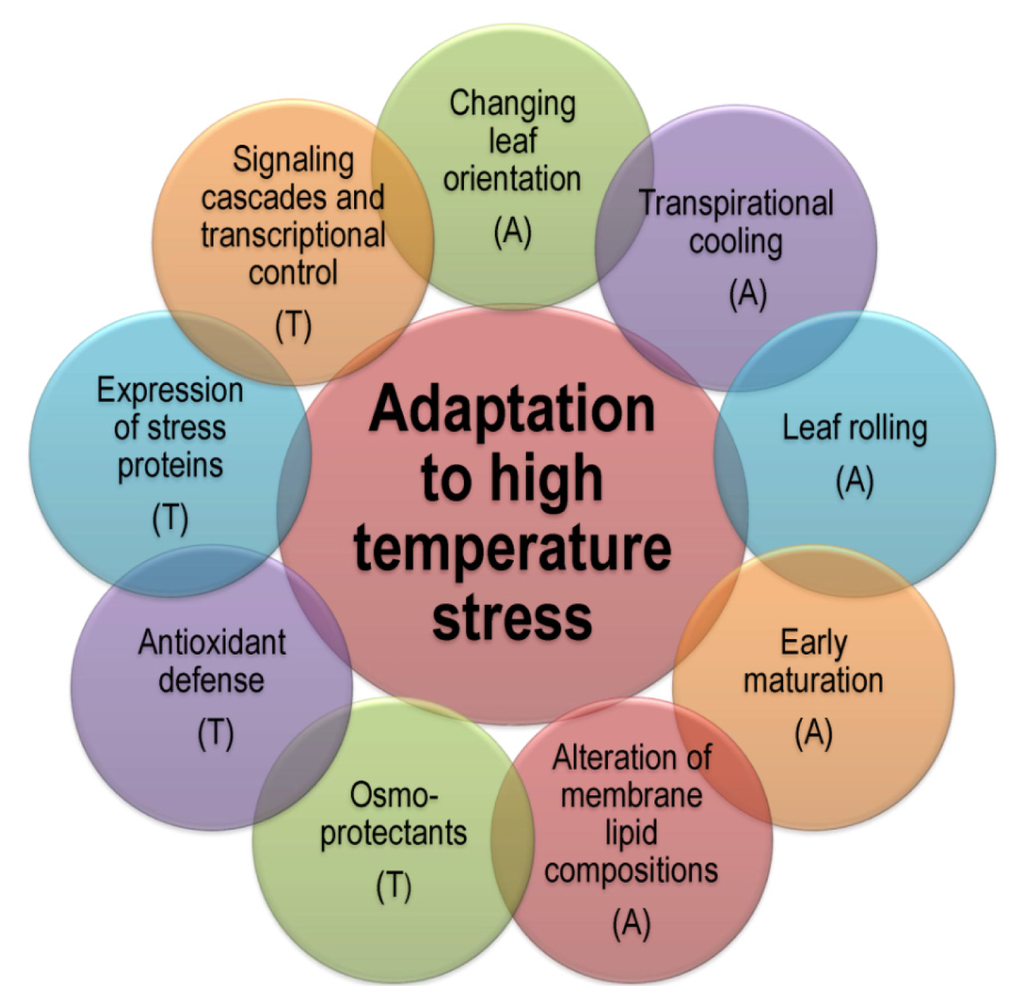Figure. Diagram representing integrated circuit of different “omics” approaches that are connected to each other at molecular genetic level associated with heat stress tolerance in plants.

Figure. Sites of production of reactive oxygen species in plants [5].

Figure. Different adaptation mechanisms of plants to high temperature. A: Avoidance, T: Tolerance.
Hasanuzzaman, M.; Nahar, K.; Alam, M.M.; Roychowdhury, R.; Fujita, M. Physiological, Biochemical, and Molecular Mechanisms of Heat Stress Tolerance in Plants. Int. J. Mol. Sci. 2013, 14, 9643-9684.
Abstract
High temperature (HT) stress is a major environmental stress that limits plant growth, metabolism, and productivity worldwide. Plant growth and development involve numerous biochemical reactions that are sensitive to temperature. Plant responses to HT vary with the degree and duration of HT and the plant type. HT is now a major concern for crop production and approaches for sustaining high yields of crop plants under HT stress are important agricultural goals. Plants possess a number of adaptive, avoidance, or acclimation mechanisms to cope with HT situations. In addition, major tolerance mechanisms that employ ion transporters, proteins, osmoprotectants, antioxidants, and other factors involved in signaling cascades and transcriptional control are activated to offset stress-induced biochemical and physiological alterations. Plant survival under HT stress depends on the ability to perceive the HT stimulus, generate and transmit the signal, and initiate appropriate physiological and biochemical changes. HT-induced gene expression and metabolite synthesis also substantially improve tolerance. The physiological and biochemical responses to heat stress are active research areas, and the molecular approaches are being adopted for developing HT tolerance in plants. This article reviews the recent findings on responses, adaptation, and tolerance to HT at the cellular, organellar, and whole plant levels and describes various approaches being taken to enhance thermotolerance in plants.
Conclusion and Future Perspective
High temperature stress has become a major concern for crop production worldwide because it greatly affects the growth, development, and productivity of plants. However, the extent to which this occurs in specific climatic zones depends on the probability and period of HT and on the diurnal timing of HT. The present rate of emission of greenhouse gases from different sources is believed responsible for a gradual increase in the world’s ambient temperature, and is resulting in global warming [216]. Therefore, plant responses and adaptation to elevated temperatures, and the mechanisms underlying the development of heat-tolerance, need to be better understood for important agricultural crops. The responses of plants to heat stress have been studied intensively in recent years; however, a complete understanding of thermotolerance mechanisms remains elusive. Temperatures change from season to season and fluctuate daily, which complicates the unambiguous definition of the stress-inducing role of temperature, since the response to various temperatures is determined by a plant’s ability to adapt to different climate regimes. Plant responses to HT also vary across and within species, as well as at different developmental stages.
Under HT conditions, plants accumulate different metabolites (such as antioxidants, osmoprotectants, heat shock proteins [HSPs], etc.) and different metabolic pathways and processes are activated. These changes emphasize the importance of physiological and molecular studies to reveal the mechanisms underlying stress responses. In addition, understanding the nature of the signaling cascades as well as the specific genes expressed in response to HT will be valuable for developing stress tolerant plants. Molecular approaches that uncover the response and tolerance mechanisms will pave the way to engineering plants capable of tolerating HT and could be the basis for development of crop varieties capable of producing economic yields under HT [24,106]. At the field level, managing or manipulating cultural practices, such as the timing and methods for sowing, irrigation management, and selection of cultivars and species, can also considerably decrease the adverse effects of HT stress. In recent decades, exogenous applications of protectants such as osmoprotectants, phytohormones, signaling molecules, trace elements, etc. have shown beneficial effects on plants growing under HT, due to the growth promoting and antioxidant activities of these compounds [15,16,18,135–137]. Engineering plants to synthesize these compounds may be an alternative way of developing thermotolerance in important crop plants and represents a potentially important area of research on thermotolerance. However, most of the experiments on HT effects currently carried out in different parts of the world are still limited to laboratory conditions and short-term studies only. Field experiments that explore different biochemical and molecular approaches and agronomic management practices are needed to investigate the actual HT responses and their effects on final crop yield.
See more at:
Nenhum comentário:
Postar um comentário